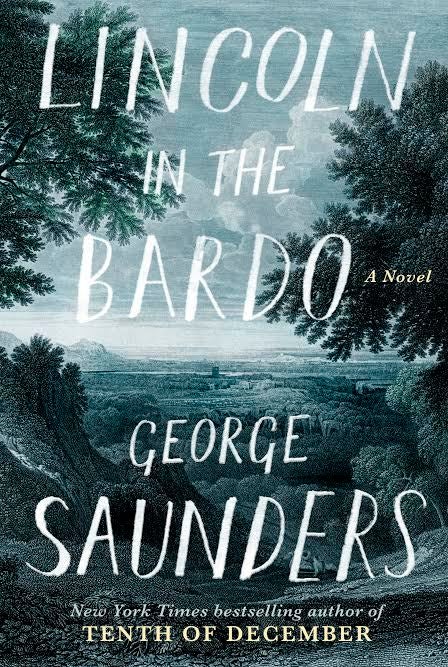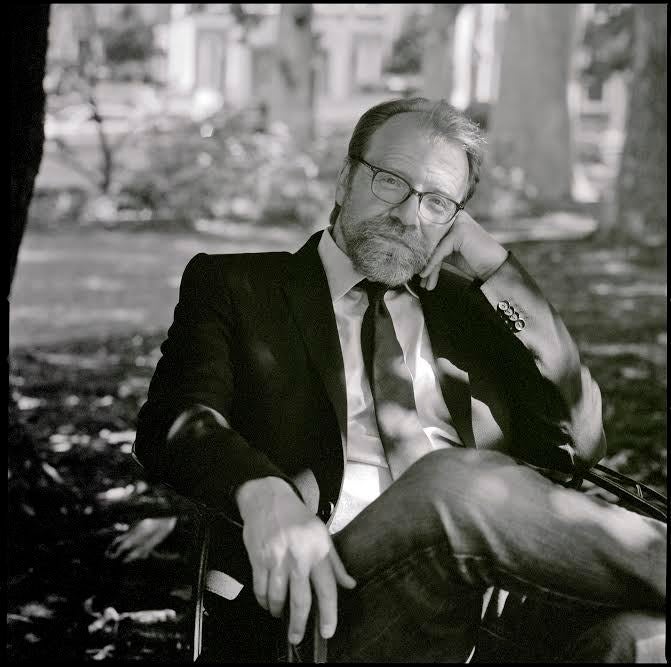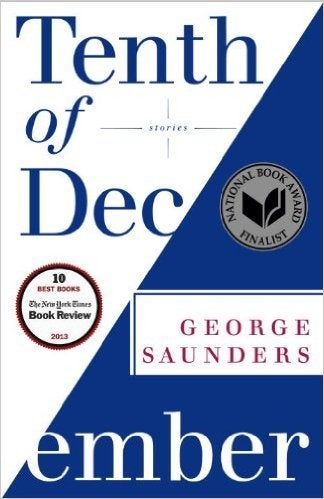
By LAUREN DALEY
I’m not sure what the Guinness World Record is for “Largest Number of Awesome Words in Two Consecutive Paragraphs,” but these next two may come close:
George Saunders — America’s best short story writer — and Nick Offerman & Megan Mullally — America’s Most Charming Couple— are all joining forces to produce a film adaptation of Saunders’ New York Times No. 1 Bestseller “Lincoln in the Bardo,” Saunders told me.
What’s more, Saunders has written a TV screenplay adaptation for his brilliant short story “Sea Oak.” He told me Amazon has green-lighted a pilot to be directed by Hiro Murai, who worked on “Atlanta,” Donald Glover’s Golden Globe-winning FX series.
… I know.
So many reasons to freak out here.
One of TIME’s 100 Most Influential People in 2013, and a 2006 MacArthur Foundation genius grant winner, Saunders is one of the English language’s greatest living writers, and a master of the short story. Chekov meets Vonnegut.
“I read Hemingway and thought it seemed like such a romantic thing to be a short story writer, laboring with little bits of truth,” he told me.
I love that.
Because that’s it — that’s exactly what a good short story writer does.
And it’s what Saunders does so well, especially in “Sea Oak” a gem of a short story, with a Saunders house-blend of dark comedy and heartbreak, ready-made for a series.
Its narrator, a male stripper who works at an airplane-themed strip joint called Joysticks (gold) lives in Sea Oak, a subsidized apartment complex in a dangerous neighborhood, with his naive aunt, sassy sister and cousin, and their babies. Min and Jade, especially, are ready-for-screen characters. If you haven’t read it, read it. It’s as heartbreaking as it is laugh-aloud-while-you’re-reading-alone funny — a Saunders trademark.
And if you haven’t yet read “Lincoln In the Bardo,” you might want to listen to it, actually. The audiobook is fully loaded with 166 actors, dozens of A-listers among them: including Offerman and Mullally, David Sedaris, Lena Dunham, Ben Stiller, Rainn Wilson, Susan Sarandon, Don Cheadle, Miranda July, Julianne Moore, Jeffrey Tambor, Carrie Brownstein … I’ll stop there.
I talked to Saunders about the film, TV pilot, Virtual Reality Lincoln, and his youth in the jungles of Sumatra.

Daley: Can you tell me a bit about the movie deal with Nick Offerman and Megan Mullally? That sounds amazing.
Saunders: Yes, we are going to co-produce it. I met Nick a couple of years ago, when he interviewed me for his book “Gumption.” We hit it off right away, spent a day wandering around New York City, and have become great friends since. He has this rare combination of quiet integrity and artistic intensity that I find really energizing and inspiring to be around. A wonderful actor and writer and guy.
And I’d been an admirer of Megan’s for many years — I think she’s a comic genius, a great actress and presence. They both have this quality of the true artist — are always asking, “How can we make something beautiful and amazing and surprising?” So part of the fun is just going to be hanging around with them while we work on this. We’re embarking on it in a collective spirit of curiosity. Like: “OK, how do we make something moving and new and cinematic from the raw materials of the book?”
Daley: You also have an Amazon pilot with "Sea Oak,” which just feels like a great story for a series. How did that come about?
Saunders: Yeah, there’s a lot going on. We’re shooting the pilot this June and it will run in September. It’s going to be directed by Hiro Murai, the visionary young director who worked on “Atlanta.” We’re casting it and location-scouting in the next few weeks.
I’d written a feature [film] version many years ago, and it hadn’t really taken off. After I finished [“Lincoln in the Bardo”] I was in this super-energized artistic state and finished a short story for The New Yorker and turned my attention back to “Sea Oak.” I was working with producer Jonathan Krauss, who has this terrific energy, and he encouraged me to try to write a 30-minute pilot, and then Jon and our co-producer Lael Smith and I were was able to pitch it to Amazon, who got it right away and have been incredibly supportive. So far I’ve written four episodes and am really enjoying it — the collaborative aspects especially. A different mode, for sure, but feels like a good way to segue back into writing fiction.
Daley: I also love that you also have Virtual Reality headsets at your book talks. What are those like?
Saunders: A few years ago this talented young director Graham Sack approached me at a reading in Austin and asked if I’d like to try VR. He’d brought a headset with him. It was pretty wonderful and he said he’d love to collaborate on something.
We approached him about “Lincoln in the Bardo,” and he made this amazing, terrifying, moving short VR film. We’re in the graveyard, ghosts are closing in, it’s this gorgeous 3-D feeling — and then here comes Lincoln. He walks right past you. It’s very moving and the first time I saw it I was sort of — well, it’s embarrassing, but I was basically crying inside my headset. Graham moved heaven and earth to get the film done, took a lot of financial and artistic risks — a really heroic venture. And Graham has come with headsets to a number of my readings — including D.C., Austin, Boston and, most recently Paris — and we’ve done this sort of variety show presentation — he shows the VR film before and after, and we recruit local actors or booksellers to help me in doing a staged reading of a section of the book. It’s been so much fun, especially the feeling of community involvement this produces.
Daley: And the audiobook cast is unbelievable. How did that come together?
Saunders: Well, the idea of doing nine hours of 19th-century monologues in my droning, South Side of Chicago accent was… daunting. Kelly Gildea, who produced the audiobook for “The Tenth of December,” said, “Hey, what if we had a different actor for each part?” Then she put it into an Excel spreadsheet and found we’d need 166 actors… But once she got David Sedaris and Nick Offerman, it was easier to get other actors, and a bunch of the audiobook all-stars. Then, you know, my family joined in… my wife is on there, our kids, my mom, my dad. Ben Stiller was the last person to read, and Kelly called me to say we’d actually done it – had managed to do the whole 166-person production with no doubling. And a musical intro/outro from Jeff Tweedy. So, yeah. A dream come true. And I was so inspired by watching Kelly decide to make this all happen at that scale.
Daley: It works so well, because the novel reads more like a play — it has almost an “Our Town” vibe.
Saunders: You know, I’d never read “Our Town,” and someone said that to me, and I was like, “Uh oh.” Then I went and read it, and it’s like “Oh, ok, I’m good.” [laughs]
Daley: [laughs] Right.
Saunders: But yeah, I had tried it years ago as a play — and it sucked. [laughs] Because when I write a play or a poem, I tend to think [uses affected accent] “Plaaay” or “Poem.” It was very….fancy.
Daley: [laughs]
Saunders: So I was bewailing the fact that I had this idea that wasn’t working, and Deborah Treisman of The New Yorker said, “Why don’t you write it in prose?” I said, “Of course!” And at the same time a former student of mine, Adam Levin, said, “What would happen if you wrote it in monologues?” So it’s funny how artistic inspiration sometimes comes into the station on separate but parallel tracks…
At one point, all the ghosts had their name at beginning of their speech, like in a play and … it just gave me a feeling like nails on a chalkboard. So I relocated the names to the bottom of the speeches, and just liked the way it looks. That’s a lot of the way form develops, just to go with that gut feeling...that this feels good.
Daley: Did you always want to be a writer?
Saunders: No, I had a really great experience with “Johnny Tremain” as a third-grader [but] I didn’t write stories until maybe college. I studied Geophysical Engineering, and I went overseas to Sumatra when I was 23, working in the deep jungle. We were about a two-hour helicopter ride from any city – very isolated. And if you weren’t getting drunk, there was lots of time to read… I read Hemingway and thought it seemed like such a romantic thing to be a short story writer, laboring with little bits of truth.

Daley: I know Chekov is a favorite. Who are some other authors who inspire you?
Saunders: Tobias Wolff is a hero of mine; I love him. Gogol, there’s something about that form of comedy that I really aspire to. I just read Ann Patchett’s “Commonwealth,” and loved it. Zadie Smith is an amazing writer and thinker. [Russian journalist and short story writer] Isaac Babel. Hemingway said Babel was the best; that he did what Hemingway did but better. Babel was a really pared-down minimalist, who could also go off into these beautiful lyrical bursts.
Daley: Did you do a lot of research on Lincoln for the novel? What were some books you read?
Saunders: You know, research can be a real excuse. You can kill years researching, and I felt pretty early on that this novel was not going to sink or swim on accuracy — this is not a 100 percent accurate depiction of Lincoln or the bardo or Oak Hill Cemetery, or of anything. The novel has a higher purpose than mere verisimilitude, so I had to allow myself to goof. So I kind of kept the research pragmatic. Having said that, I think I have about 300 books on Lincoln in my study. It was a process of just putting as much in my head as I could stand, hoping it would get channeled in a useful way, as needed…
Right after I heard that story [about Lincoln holding his dead son in the crypt], I read about Willie’s death because I knew I needed to know more about that part. I found a cool book about Lincoln’s appearance, ‘“The Physical Lincoln,” [ by John G. Sotos] … Another was “The Unpopular Mr. Lincoln,” by Larry Tagg… Another was “The Lincolns: Portrait of a Marriage,” by Daniel Mark Epstein, who’s a beautiful stylist.
Daley: So what will you do next?
Saunders: I’m going back to short stories… I have too many failed novels in my past [laughs.] My thing is, trust that truth can come through small stories.
Daley: Anything you’d like to add that we haven’t talked about?
Saunders: Well, I’ve done around 50 events in the last month— in 24 U.S. cities and then in Ireland, England, and France— and something that has really [stood out to me] is how lucky a writer is, to get to meet his readers in person. I’ve gotten so much warmth and encouragement, and am hoping, now, to convert all of that kindness into artistic courage. You get a nightly demonstration of how generous readers are, and how much they want you to try the big things, and of how far they’re willing to travel with you on that trip. It’s made me feel very grateful — for my readers and for the tremendous opportunity my life has given me to connect with other people. It’s also given me a lot of encouragement in this strange political time, to reconnect with so many Americans and be inspired by their good sense and wit and generosity of spirit.
Interview has been edited and condensed.
